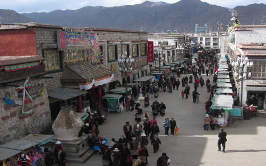Indian Subcontinent
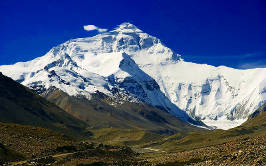
South Asia comprises those countries lying between the Himalaya range of mountains and the Indian Ocean (north to south) and between the Ganga and Indus river valleys (east to west). The Indian Ocean shoreline is divided between the Arabian Sea (in the west) and the Bay of Bengal (in the east). The extensive, triangular-shaped landmass of South Asia is sometimes referred to as "the Indian Subcontinent", or simply "the Subcontinent"
Bhutan
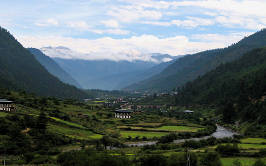
Bhutan is a small country in the Himalayas between the Tibet Autonomous Region of China and India.
Besides the stunning natural scenery, the enduring image of the country for most visitors is the strong sense of culture and tradition that binds the kingdom and clearly distinguishes it from its larger neighbors. Bhutan is the only Vajrayana Buddhist nation in the world, and the profound teachings of this tradition remain well preserved and exert a strong influence in all aspects of life. Due to its pristine environment and harmonious society, the tiny Kingdom of Bhutan has been called "The Last Shangrila."
While Bhutanese villages are extremeley picturesque, the towns are generally characterized by their harsh concrete structures and lack of green public spaces. Notable exceptions to this generaliztion are Trashigang and Trashiyangtse, where the buildings are constructed of traditional material.
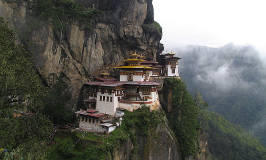
Scenery: As most of Bhutan is in the Himalayas and foothills, scenery is mostly characterized by high mountains and towns precariously perched on ridges. The Paro and Bumthang valleys are especially impressive.
The dzongs are ancient fortresses that now serve as the civil and monastic administration headquarters of each district. Apart from the architecture, which in itself makes a dzong worth visiting, they also hold many art treasures.
Sacred sites
- Kurje Lhakhang, Jakar. A temple built around a cave with a body print of Guru Rinpoche embedded in the wall. Guru Rinpoche practiced meditation here on his first visit to Bhutan and as such it is the earliest Buddhist relic in the country.
- Taktsang Monastery (Tiger's Nest), Paro. This is one of the most important Buddhist sites in the world, and Guru Rinpoche visited here on his second visit to Bhutan. The temple is built on a 1,200 meter cliff and is Bhutan's most well known sacred site.
- Singye Dzong , Lhuentse. This is is a sacred valley located near the Tibetan border. The main temple in the valley was founded by Yeshi Tsogyal, and Guru Rinpoche visited the region on his second visit to Bhutan. However, partly due to the fact that the valley is in a sensitive area near the border and also partly due to Bhutan wishing to preserve the sanctity of its sacred sites, the valley is not open for tourists.
India
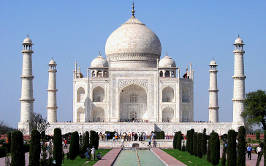
India is the largest country in the Indian Subcontinent and shares borders with Pakistan to the west, China and Nepal to the north, Bhutan to the north-east, and Bangladesh and Myanmar to the east. Sri Lanka, the Maldives and Indonesia lie to the south-east in the Indian Ocean. It is the seventh largest country in the world by area and, with over a billion people, is second only to China in population. It's an extremely diverse country, with vast differences in geography, climate, culture, language and ethnicity across its expanse, and prides itself on being the largest democracy on Earth.
If you really want to see all the worth visiting places in India, one tourist visa of six months can be argued to be considered enough. There are more tourist destinations in India then can be mentioned in one book. Almost every State in India has over ten major tourist destinations and there are cities which can not be fully experienced even in One full week. Not to forget that several states of India are bigger than most of the countries in the world and there are twenty-eight states in India. Some highly recommended sights in India :
- The Taj Mahal : It is actually bigger and more majestic than what it looks in the photograph.
- Varanasi : Hindu religious rituals, some harking back to the Vedic age, 5000 years ago, Varanasi is the oldest living city of the world and the birth place of Hinduism. Don't miss the evening Ganga Aarti.
- Tigers : They may or may not be present in all the tiger reserves but your chances of seeing a tiger are fairly good in Bandhavgarh Or Ranathambore Tiger reserves.
- Sangla Valley : Considered one of the most beautiful valleys of the world lies in the upper regions of Himachal Pradesh. It is Extremely scenic with photogenic landscapes and unforgettable Landscapes.
- Leh : Considered to be on the top of the world. One of the highest inhabited cities of the world. It gives a different idea of high altitude altogether with unbelievable landscapes.
- Srinagar : It is the capital of the State of Jammu and Kashmir. Extremely beautiful city in the midst of the Himalayas with a very beautiful Dal lake in it.
- Gangtok : Capital city of Sikkim. Gangtok is a bewitching hill-station located amidst the multiple-hued mountains of Sikkim.
- Goa : Ruled by Portuguese for over 400 years, Goa is a cocktail of Indian and Portuguese culture. Quite a different kind of place altogether, Goa is full of beautiful beaches and flocking tourists.
- Pondicherry : Pondicherry was a French colony over two hundred years and has a lot of sighting of French influence throughout it's territories. Now tourists often flock there for spiritual ashrams or enjoyable pubs and parties.
- Chennai : It is the Capital city of the southeren state of Tamilnadu in SouthIndia and a different kind of Indian city altogether. Buying a saree or Marina beach can be considered worth-while in Chennai.
- Tirupati Balaji : If you want to see the material richness of a religious place, visit this temple. It is considered to be the richest temple in the world and one surprising sight to see for a non Indian.
- Nalanda : Related to Buddhism, It was the oldest university of the world later on destroyed completely during the Muslim invasions of India. Sights of Buddhist interest like Pavapuri and Rajgir are in the vicinity.
- Golden Temple : An actual Temple plated with Gold is one of Sikhism's holiest shrines. Looks very serene early in the mornings.
- Khajuraho : Supposedly the birth place of Kamasutra, Khajuraho is full of temples with erotic sculptures all around them. One of the most interesting and less talked about aspects of Hindu culture.
- Kochi : In a State full of secluded and ravishing beaches, Kochi is one of the most sought after tourist destination. It is advisable to visit the surrounding beach cities of Kochi. Don't forget to experience backwaters of Kerala in a house boat.
- Andamans : Beautiful Island territory of India in the Bay of Bengal, Andaman islands can be considered one of the best island destinations in the world.
- Jaisalmer : A city located in the middle of desert, Jaisalmer is a place to go for watching the beautiful view of sun lighted virgin deserts of Thar Desert.
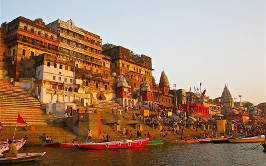
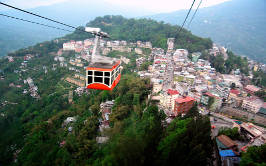
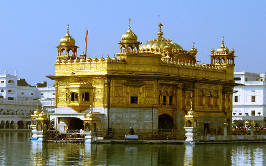
Maldives
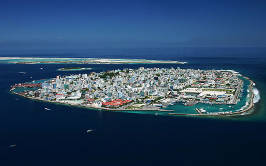
The Maldives are an archipelago of 1,192 coral islands grouped into 26 coral atolls (200 inhabited islands, plus 80 islands with tourist resorts) in the Indian Ocean. They lie south-southwest of India and are considered part of Southern Asia.
Diving and snorkelling
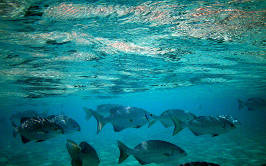
Aside from making the water bungalow rock on your honeymoon, the primary activity on the Maldives is scuba diving. The atolls are all coral reefs hundreds of kilometers away from any major landmass, meaning that water clarity is excellent and underwater life is abundant. Manta rays, sharks, even a few wrecks, you name it, you can find it in the Maldives.
While diving is very good by world standards even in the immediate vicinity of Male, visibility and the chance of encountering large pelagics increases as you head to the outer atolls. Many divers opt for liveaboards, which can actually work out much cheaper than paying high resort fees. Currents vary considerably, with generally little inside the atolls but some powerful streams to be found on the sides facing the open sea. Water in the Maldives is warm throughout the year and a 3mm shorty or Lycra diveskin is plenty. Diving is possible throughout the year, but rain, wind and waves are most common during the season of the southwest monsoon (June-August). The best time for scuba diving is from January to April, when the sea is calm, the sun is shining and the visibility can reach 30 m. Decompression chambers can be found on Bandos in Kaafu (15 min from Male), Kuredu in Lhaviyani Atoll and at Kuramathi on Alifu.
Surfing
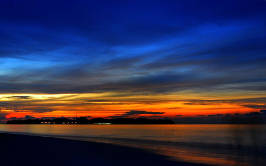
The Maldives is becoming an increasingly popular surfing destination. Turquoise water and perfect waves makes it an ideal and uncrowded destination for surfers looking for smooth surfing conditions.
The best period for surfing in the Maldives is between March and October; the biggest waves occurring in June, July and August. This paradise is exposed to the same swells as Indonesia is, except that its higher latitude and its South-East exposure offers cooler and less hardcore surfing. The recent O’Neil Deep Blue Contests held in the Maldives has placed Maldives firmly on the world’s surf map. While most of the recognized surf breaks are in Male’ Atoll, there is certainly more to be discovered.
Mauritius
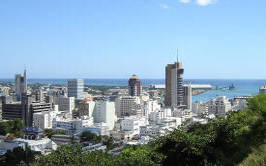
Mauritius is a small, multicultural island in the Indian Ocean, east of Madagascar and southeast of the Seychelles. Mauritius also controls Rodrigues Island and the remote, sparsely populated Agalega and Cargados Garayos (Saint Brandon) islands.
- Grand Bay was the first area of the island to fully experience the tourist boom. A shopping and leisure paradise, Grand Bay is also where Mauritians go when they want a fun-filled night out (restaurants, bars and discos). Recently renovated, La Cuvette beach is well worth a visit.
- Pereybere — The wonderful Pereybere public beach is popular because of its shopping facilities, restaurants and pubs.
- L'Aventure du Sucre — French for Sugar Adventure, this old sugar factory has been converted into a modern museum retracing the influence of the sugar industry on the history and economy of Mauritius. A must-see for tourists who want to better understand the island.
- Balaclava Ruins — A few metres away from Baie aux Tortues, which 17th century sailors named after the many tortoises in the area, can be found the ruins of the old Balaclava estate. Visitors can see the sea walls, whose initial foundations were laid down by Mahé de Labourdonnais. The location of the ruins now forms part of Maritim Hotel, and public access may not be possible.
- The Triolet Shivala — The longest village on the island, Triolet offers an opportunity to visit the biggest Hindu temple, the Maheswarnath, first built in 1819 in honour of the Gods Shiva, Krishna, Vishnu, Muruga, Brahma and Ganesha.
- The Labourdonnais Orchards — Discover a large variety of tropical fruit trees, and colourful and perfumed exotic flowers. Trips on mountain bikes or hiking are possible.
- The Caudan Waterfront — The Caudan Waterfront and it's surroundings has a great collection of local souvenir shops and other foreign brand materials such as clothes, spirits . . . In addition to the harbor of Mauritius, you will also find the movie theater, game arcades, local restaurants. . . .
- The "Bazard" of Port-Louis — Literally translated as "The market of Port Louis" — here you will find a variety of local snacks and tropical fruits. These are the cheapest food you will find in the capital city. Numerous shops sell crafted objects such as the "goni" basket. Unfortunately you will also find a lot of stalls selling pirate versions of programs, movies and games: they are extremely cheap but still are illegal and do not guarantee quality. Like all crowded areas, be wary of your surroundings and keep your belongings close to you. Food sold on the street may have health issues, but those are for the most part rare. If you have any allergies though, refrain from eating at these stalls.
- Restaurants — Don't hesitate to go to the various local restaurants around the city. Although many of them advertise a specific ethnic cuisine, like everywhere around the world they have their own mix of traditional and local. You might discover that 'fried rice' can have more than one flavor.
- The SSR Botanical Garden If you want to see some plants originating from Mauritius, then this is the place for you. The SSR botanical garden is the oldest botanical garden in the Southern Hemisphere. It was founded by Pierre Poivre (1719 – 1786) in 1770, contains some flora unique to Mauritius and covers an area of around 37 hectares. It also has several animals, being especially famous for its fish, deer and tortoises, as well as an old replica of a sugar mill.
Nepal
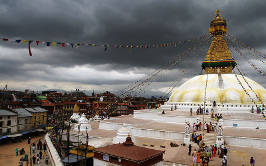
Nepal is a landlocked country in Southern Asia, between the Tibet autonomous region of China and India. It contains eight of the world's 10 highest peaks, including Mount Everest - the world's tallest - on the border with Tibet, and Lumbini, the birth place of Gautama Buddha, the founder of Buddhism. Nepal recently was declared a republic and has abolished the monarchy.
Trekking
A total of 101,320 trekkers visited Nepal in 2007. Out of total 60,237 (59.4%) visited Annapurna area while those visiting the Everest and Langtang regions accounted for 26,511 (26.5%) and 8,165 (8.1%) respectively.
"Tea-House Trekking" is the easiest way to trek as it doesn't require support. Tea Houses have now developed into full-scale tourist lodges with hot showers, pizza, pasta and beer. The day's hikes are between lodge-filled settlements or villages: there's no need for tents, food, water, or beer-- all those things, plus luxuries such as apple-pie, can be purchased along the way. Physical requirements go from very soft to strenuous.
Facilities available in remote areas are less extensive than in the more popular areas. It may be advisable to visit such regions with organised groups, including guide, porters and full support. Manaslu, Kanchenjunga, Dolpo, Mustang and Humla are in remote areas. Many of them require also special permits.
Annapurna Region Treks
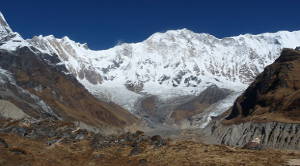
Annapurna - North of Pokhara, from lush middle hills into high mountains.
Annapurna Circuit: A 2-3 week trek around the Annapurna mountains, leads up the Maryangdi river to Manang, over Thorung La (5400m) to the Hindu temples at Muktinath. Down the Kali Gandaki on the Jomsom trail - The last week of the Annapurna Circuit, done in the opposite direction. Known as the "Apple-Pie Trek" partly for crossing the apple growing region of Nepal, and partly for being one of the easier treks, enjoying Gurung and Thakali hospitality. Up through spring rhododendron blooms to Poon Hill for a dawn Himalayan vista. Another shorter but spectacular mini-circuit is the Nayapul-Ghandruk-Ghorepani-PoonHill-Nayapul route.
Annapurna Sanctuary: A trek up into the very heart of the range provides an awesome 360 degree high mountain skyline.
Everest Region Treks
Everest lies in the region known as Khumbu - To get here, take a bus to Jiri or fly to Lukla then hike up to Namche Bazzar, capital of the Sherpa lands at the foot of Everest. Main "teahouse trek" regions, in each of these areas there are a number of trail options, there is plenty of scope for short treks of less than a week to much longer if you have time and wanderlust.
Everest Base Camp Trek: Lukla to EBC, Stunning scenery, Wonderful Sherpa people. The most popular trek is up to Everest Base Camp and an ascent of Kalar Patar. Visit the Buddhist Tengboche monastery for the Mani Rimdu festival in November.
Gokyo: Lukla to the sacred lakes of Gokyo. Explore the Gokyo valley with its sacred lakes and stupendous views of four 8000m peaks. Or a circuit of the region crossing the high passes or Cho La and Renjo La.
Numbur Cheese Circuit Trek through the largest cheese producing area, via the sacred lakes of Jata Pokhari and Panch Pokhari to Numburchuili base camp.
Island Peak Trek in the Everest region takes in some of the most spectacular scenery in the Himalayas. See 'Regions' - Khumbu
Rafting
Rafting trips for various durations and all levels of experience leave from Kathmandu and Pokhara.
It is also possible depending on the river to practice Kayaking and canyoning. Rafting is considered dangerous on most rivers in Nepal (on all during monsoon)
Jungle Safari
Chitwan National Park offers elephant rides, jungle canoeing, nature walks, and birding, as well as more adventurous tiger and rhino-viewing. There are also many other less visited parks like Bardiya and Sagarmatha.
Seychelles
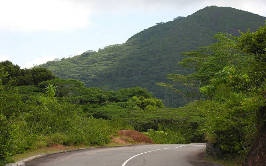
The Seychelles are a group of 115 islands, only a few inhabited, in the Indian Ocean that lie off the coast of East Africa, northeast of Madagascar.
Visit the beaches. Many of the beaches are untouched by man's influence and are refreshingly uncrowded. They offer clear blue skies and a tranquility you will rarely find. A hike along the coastline from Beau Vallon to Anse Major will take about 1.5-2 hours and your reward will be a small deserted beach that's fit for a king. The scenery along the hike is breath-taking. Not all beaches are suitable for swimming depending on the time of year, due to the seasonal winds. Do not ignore warning signs indicating that a beach is hazardous for swimming, no matter how appealing the waters may look.
Vallee de Mai is a national park and world heritage site, home to amazing flora and fauna, including the world's largest seed: the coco de mer.
Aldabra Atoll: The world's largest coral atoll that stretches about 22 miles east to west and encloses a huge tidal lagoon. Aldabra is the original home of the giant land tortoise and tiger sharks and manta rays can also often be seen here.
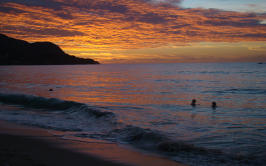
Watersports: The warm Indian Ocean waters make Seychelles the perfect place for the water enthusiasts. Explore on the board of a yacht, power boat, catamaran or sailboat. Windsurfing is also popular and the best time for this activity is usually around May and October, at the start and end of the trade winds.
Scuba diving, snorkeling, and fishing are also extremely popular and can be done almost anywhere in Seychelles. Baie Ternay is superb and easily acccessible by glass bottom boat tour from Beau Vallon beach - leave yourself an empty day and walk the beach for a 'last minute' booking - great deals can be bartered.
Seychelles also has numerous markets, art galleries and shops, colonial Creole-style plantation houses, and the main island of Mahé has six museums, a botanical garden, and several national monuments. The market downtown Victoria has a good selection of local produce, and spices for sale that are all grown locally and 100% authentic.
Tibet
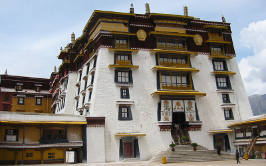
Tibet is an autonomous region of China. Entering Tibet you feel as though you've entered an entirely different world. The traditional Tibetan culture, though heavily diluted recently by government-sponsored migrations of Han and Hui Chinese, remains strong.
Much of Lhasa has been replaced by post-1950 Chinese developments with only a small quarter dating from pre-invasion times. This part is now under renovation to attract tourists. It is still worth to take a stroll through the old part of Lhasa and buy goods from Tibetan vendors, who sometimes come from remote provinces of Tibet. Watch the impressive bargaining for Shish stones but refrain from buying turquoise or coral items as most of them are synthetic or dyed. Nevertheless Tibetan vendors have a huge range of beautiful Tibetan articles and it pays out to buy directly from them instead of spending money in shopping malls which started to appear everywhere in the centre of Lhasa.
A must are the small Tibetan restaurants who serve authentic Tibetan food. If you have never tried momos or gyantok, a definite must together with a cup of salted Tibetan butter tea.
For an authentic, fulfilling visit to Tibet, you must have a native Tibetan guide. Many of the Chinese guides are relocated from other areas of China and don't have a real understanding of the people or culture of Tibet that make the country so amazing.
- The Potala Palace, the home of successive Dalai Lamas is in Lhasa
- The Jokhang Temple in Lhasa was built in 647 AD by Songtsen Gampo and is one of the holiest sites in Tibet.
- The Barkhor Street in Lhasa is a street of traditional Tibetan buildings that encompasses the Jokhang Temple.
- Samye Monastery - constructed in 779AD, Samye was the first Buddhist Monastery established in Tibet, and is located near Dranang, Shannan Prefecture, 150 km south-east of Lhasa.
- Tashilhunpo Monastery, the traditional seat of the Panchen Lamas. It was constructed in 1447 and is located in Xigatse
- The Rongbuk Monastery, one of the highest monasteries in the world, from which the view of the Mt. Everest is just amazing.
